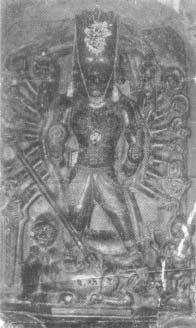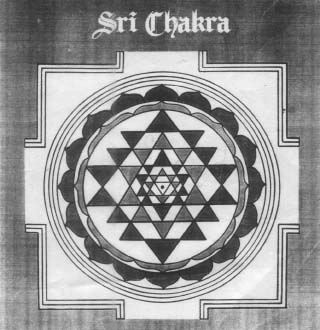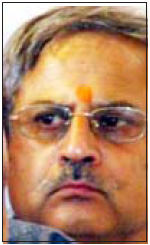Hari
Parbat - the Reservoir of Religio-Cultural Strength
By
Upender Ambardar
The
pious and sacred places of pilgrimages have deep roots in our socio-religious
traditions. They are an inseparable part of our cultural heritage. Kashmir has
been a cradle of spiritual and cultural rejuvenation since time immemorial. The
shrines and holy pilgrimage centres located at every nook and corner of the
valley are places of devotion and reverence for the entire Kashmiri Pandit
Community. They are not only a great source of our spiritual inspiration but
also the main strength of our faith and devotion.
Hari Parbat (the hill of Sharika) situated at
the periphery of Srinagar city is an ancient and one of the holiest places of
Kashmir. It is the abode of Mahashakti - the Divine Mother Jagatamba Sharika
Bhagwati, also known as Maha Tripursundhari or Rajrajeshwari (locally called as
Hari). The eighteen armed Goddess Sharika (Ashtadushbuja*, Fig. 1) is regarded
as the Presiding Deity (Isht-Devi) of Srinagar city. The Goddess Sharika is
manifestation of the foremost Deity and Supreme Mother of the Universe - the
Goddess Durga. The Goddess Sharika is represented by a `Soyambhu' Shrichakra (Mahamaha
Shrichakra), also called Mahashriyantra, which consists of circular mystic
impressions and triangular patterns with a dot (bindhu) at the centre. The
mystic Shrichakra engraved on a vertical holy rock (shila) is located at the
middle of western face of Hari Parbat.
This very shila smeared with a paste of
lead-oxide or red lead (sindhoor) and decorated with silver foils (ropa-vark)
and fresh flowers is the holy shrine of Chakrishwar. The Deity is known as Shri
Chakrishwari (Fig. 2). The shrine can be approached from Deviangan by a flight
of chiselled stones, numbering one hundred and eleven. It is perhaps due to the
Goddess Shrichakra that the capital city of Kashmir is said to have derived it's
name of Srinagar (Shrinagra).
As for the `Visishtadhvaita' doctrine, `Shri' is
the Divine Consort of The Lord and is said to play an intermediatory role
between God and the human soul. The Shrichakra (Fig. 3) is a symbolic
representation of the cosmic union of the Lord Shiva and Shakti. The Shrichakra
is the most famous `Yantra' and Yantra is indispensable in the
Tantra Worship.
Every Goddess is represented by an individual `Yantra'
and among all the Yantras, the most famous and venerated one is the `Shri-yantra'.
The yantra inscribed with specific mantras represents the Divine
Mother, who is the cause of creation, sustenance and dissolution of the Cosmos.

Fig. 1 : Ashtadushbuja
*Gratitude is expressed to Mrs.
Bimla Rainaji for procuring and providing this rare photograph which is
captioned as "The Centuries old idol of Goddess Ashtadushbuja, Mata Kaliji,
stolen by some miscreants from an ancient temple of Hari Parbat in Srinagar.
These attributes of shakti are
recognised by the great Vedantin Adishankaracharya. The very first line of the
first shaloka of his famous hymn `Saundarya-Lehri', states clearly that
Lord Shiva is powerless without the divine energy of the Shakti. Some of the
selected shaloka's of `Saundarya-Lehri', `Panchastavi' and `Durga Saptshati'
dedicated to the praises of the Divine Mother are recited regularly every
morning by the devotees at the holy shrine of Shri Chakrishwari. The shrine of
Chakrishwar has been a place of worship from the day, the Goddess Sharika
manifested Herself in the form of a `shila' on the Hari-Parbat. Various
names such as `Pradyuman Peeth', `Sidh-Peeth', `Shakti-Peeth', besides `Sharika-Peeth'
have been assigned to the holy shrine of the Goddess Chakrishwari.
The devotees often recite the `Sharika
Mahatmya' sholaka with faith and reverence during the circumambulation (parikrama)
of the shrine. This sholaka clearly refers to the Pradyuman-peeth as being the
sacred seat of `Shri-Chakra' on the Hari-Parbat.

A verse from the `Rudra Yamla
Tantra' is inscribed on the marble slab installed above the holy `shila'.
This verse speaks about the nature and form of Shri-Chakra - the Superme Goddess
Sharika.

The `Shakt Shastra' also admires
and glorifies the Goddess Sharika as the most adorable and magnificient Deity
with eighteen arms, who takes good care of the universe and Her devotees.

To worship the Supreme Goddess, the
devotees would go to Hari Parbat regularly and reach the shrine of Chakrishwar
to be at the holy feet of the Divine Mother in the wee hours of the morning.
Phagun Krishna Paksh Ashtami (Hora Ashtami or Hur Aathum) and Ashad Shukla Paksh
Saptami, Ashtami and Navami (Har Satum, Har Aathum and Har Navum) are the
auspicious days for the devotional congregational prayers at the Sharika-peeth
Chakrishwar.
Asad Navami (Har Navum) is said to
be the Birthday of Sharika Bhagwati. On this day, the devotees make sacrificial
offering of `Taher-charvan' (Taher - rice boiled with turmeric
powder and mixed with oil and salt; charvan - cooked liver of goat) to
the Supreme Goddess.
This ritual is locally known as `Chout
Kharoun'. On `Navreh' (the New Year Day of Kashmiri Pandits), during the
month of Magh and Navratra days' (Nav-Durgah), the devotees regularly visit the
Hari-Parbat for special prayers and wroship.
Earlier, the Birthday of Jagat Amba
sharika Bhagwati used to be celebrated by performing a `Mahachandi Yagna', which
would commence on Ashad Saptami (Har Satum) and culminate on Ashad Shukla Paksh
Navami (Har Navum) with a sacrificial offering of a lamb called `Raje-Kath'.
Presently, `Har-Navum', the holy birthday festival of the Goddess Sharika is
celebrated at Chakrishwar shrine with a night long singing of hymns and
bhajans in the praise of the Goddess.
Some of the devotees prefer to do
parikrama (prakrum) for the complete month of Magh right from the Lord
Ganishs' temple (Ganishon), passing through Devi-Angan right upto Kathi-Darwaza.
Pir Pandit Padshah Resh Peer, one
of the greatest saints of Kashmir of 17th, Century is said to have performed
circumambulation of Hari-Parbat (a distance of about three miles) on his knees
for forty days in the wee hours of the morning.
A legend from the `Sharika Mahatmya'
records that in order to save and free the residents of the valley (Satidesh)
from the evil deeds of the demon, the Mother Goddess Ashtadushbuja Jagatamba
Durga took the form of a bird (Har in Kashmiri and `myna' in
Hindi).
On the day of Ashad Shukla Paksh
Navami (Har Navum), it is believed to have carried a celestial pebble in its'
beak and dropped it on the demon to crush it to death. A miracle happened and
the celestial pebble is said to have assumed the shape and form of a hillock
giving the name of Sharika Parbat or Hari Parbat to the hillock.
Subsequently, the Goddess Sharika
(represented by the mystic `Soyambhu' Shrichakra), made Her permanent Abode on
the Western face of the hillock (Hari Parbat) on a vertical rock (shila) to
assure the native people of Her presence and protection.
The whole hillock of Hari Parbat is
a hallowed place. A number of temples and holy spots representing the different
Deities are located on its' all sides.
It is because of this belief that
the devotees undertake a circumambulation (parikrama) of the whole
hillock of Hari Parbat. The parikrama starts from the Lord Ganeshs'
shrine (Ganishon), which is located on the south-western corner of Hari
Parbat. Inside the temple, the Deity is represented by a huge `shila', smeared
with lead-oxide or red lead (sindhoor). The Principal Devta Ganisha (Adideva
Ganesha) is also known by the names of Ganpati, Vinayak, Heramba, Ekadenta,
Lambodara, Vignesa, Vighna-Hari and Gajanana. Believed to be kind, generous and
calm, Lord Ganesha is always invoked before starting any auspicious event or
religious ceremony. Ganpati is worshipped both in the form of an image and
yantra. The `Swastika' is also regarded as a graphic symbol of Lord Ganesha.
From Lord Ganeshjis' temple, there
are two parikrama routes; one, along foot-hill of the hillock and the
other along the fortified stone wall locally known as `Kalai'. The
devotees have the option of taking either of the two routes.
The next place of obeisance on
parikrama route is the `Saptrishi sthapna (Satresh), which is marked by an
open space on slope of the hillock near a big boulder in the vicinity of a
Chinar tree. It is at this very spot, that the devotees used to
ascertain their luck (locally known as phall) by random picking-up of
some rice grains scattered on the boulder. (even number for bad and odd number
for good luck) The Saptrishi, also called `Praja-patis`` are regarded as the
mind-born sons (manus-putra's) of Brahma.
In the `Shatpath-Brahman', their
names are given as Gotama, Bhardwaja, Vishwamitra, Vasishta, Kashyap, Atri
and Jamad-agni. The seven Rishis are represented in the sky by seven
stars known by the name of Great Bear. (Satresh).
Furtheron, the next holy spot to
appear during parikrama is the "thapna" of the Goddess Kali, which
is marked by a small temple adjacent to a Chinar tree. Mahakali,
the consort of Mahakal, the eternal time represents one of the aspects of Shakti,
the primordial energy, which comprises the creation (Srishti) and
dissolution (pralay). Kali, the eternal symbol of the mother cult
destroys the evil and showers blessings on her devotees.
In front of the Kali-mandir, a
large flat chunk of land measuring about ten kanals or so is known by the name
of `Sidh-Peeth' - A place of awakened Divine presence. The Sidh-Peeth is
believed to be invested with strong divine spiritual vibrations. Usually, the
devotees worship and chant the holy name of the Eternal Mother at the Sidh-peeth
in the auspicious hour's of pre-dawn. (Brahma-murta). The great saints of
Kashmir, Pt. Madhav Joo Dhar, Rupe Bhowani, Krishna Kar, Resh Peer, Sahib Koul
and many others' are said to have meditated and succeeded in their spiritual
pursuits here at the Sidh-Peeth near the Chinar tree. The Sidh-Peeth also
commands a most picturesque and panoramic view of the whole area.
Next, on the parikrama route
of Hari Parbat is a vast stretch of open space known by the name of `Devi-Angan'
- the playfield of the Cosmic Mother. It is studded with small hutments for the
purpose of worship and meditation. Due to scenic charm and absorbing natural
beauty, Devi-Angan is also a place for religious and social festivities.
Those of the devotees, who can not
pay obeisance at the holy shrine of Chakrishwar, do pray and worship at the
Devi-Angan. The holy shrine of Shrichakra with the adjacent open space known by
the same name of Devi-angan is also present in TamilNadu.
Next holy spot on parikrama
of Hari-Parbat is the "thapna" of `Hari', represented by a rock (shila),
located on the north-eastern face of the hillock. The shila is also
smeared with sindhoor. Earlier a small dharamshalla used to exist near this
thapna. The devotees after performing pooja at this spot, take a symbolic
`round-turn' parikrama in front of the shila, pronouncing loudly the holy words
"Hari (Maujee) Kartum Yari" (The Mother Goddess bless me).

Fig. 2 : Shri Chakreshwari
In front of Devi-angan, the two
parikrama routes, one along the fortification wall (Kalai) and the other
below the foothill, merge together.
From here, the devotees while
performing parikrama pay their obeisance to the Goddess Mahalakshmi by
salutations (namaskar with folded hands) near Mahalakshmi thapna, which
is situated at a higher elevation near the thapna of `Hari'. The devotees do not
offer pooja here specifically, as Kashmiri Pandits have preferential adoration
for the Goddess Saraswati - the Goddess of knowledge and learning rather than
Laxmi - the Goddess of fortune and wealth.
Next and opposite to Mahalakshmi
thapna, on the left side of parikrama route, there is a temple called
`Amber Kouls' mandir, though some people wrongly refer it as Ram Kouls' mandir.
A little distance away from this temple is `Waris Khan's chah.' Amber
Koul's temple is believed to be the first Lord Krishna's temple in the valley.
The devotees after performing pooja and meditation would enjoy a panaromic view
of the Dal-lake, while taking rest on a wooden platform of the temple facing
east. Next on the parikrama, falls the thapna of `Vamdhev', which
is located on the left side of the route. Vamdhev is regarded as the Divine
Consort of the Goddess Raghnya. Previously, there existed a stone statue of Lord
Vamdhev and a small "Dharmshalla". The devotees also perform parikrama
here.
Pokhribal-
the shrine of the Mother Raghnya is the next holy spot on the parikrama route.
It has a holy spring inside the temple complex. A `samput yagnya' used to
be performed in honour of the Goddess Raghnya especially on Shuklapaksh Ashtamis
and other auspicious days.
A small Hanuman temple located on
the right side of the foothill is the last holy spot on the parikrama
route.
The circumbulation or parikrama ("prakrum")
of the Hari-Parbat ends at "Kathi-Darwaga", which is one of the two main gates
of the township around Hari Parbat, the other being "Sangeen-darwaza" towards
Hawal. Hari Parbat is surrounded by orchards of almonds (called Badam-Vari)
on its' three sides i.e. on north, west and east. During spring the `badam-vari'
presents the look of a fairyland and people visit it to enjoy the almond
blossom, localty known as "Badam phulai".
A regular visit to Hari Parbat used
to be an integral part of the socio-religious life of every Kashmiri Pandit. The
devotees would flock to the holy shrine early in the morning for solace,
solitude, self purification and spiritual pursuits.
It is rightly believed that those
who worship at Hari Parbat are deemed to have worshipped all the Gods and
Goddesses of the Hindu mythology.
Undoubtedly, the whole hillock of
Hari Parbat is a hallowed place and a source of spiritual, religious and
cultural strength. It is a place of devotion and reverence for the entire
Kashmiri Pandit Community.

Fig. 3 : Sri Chakra
Source: Vitasta
| 


















No one has commented yet. Be the first!